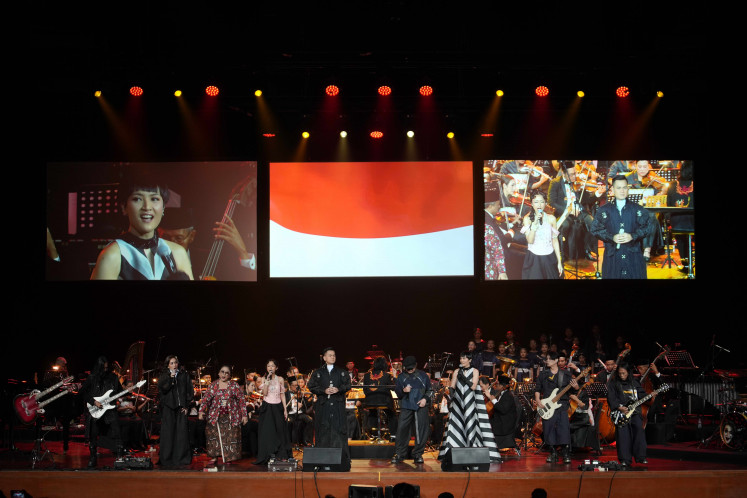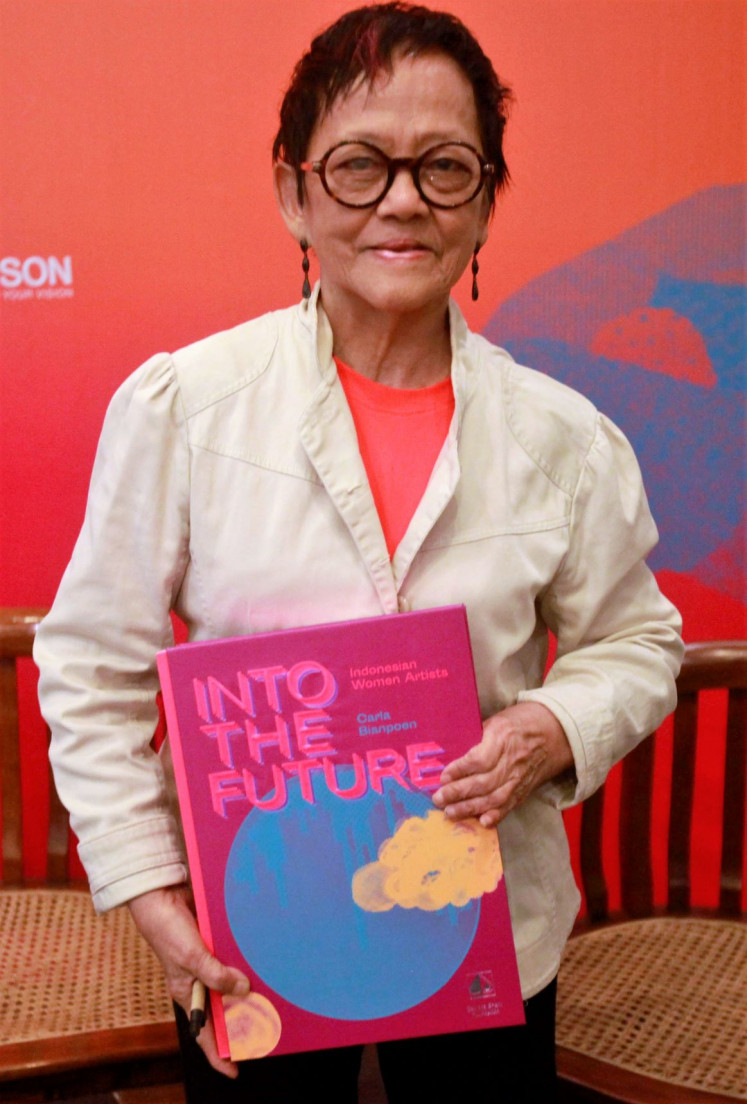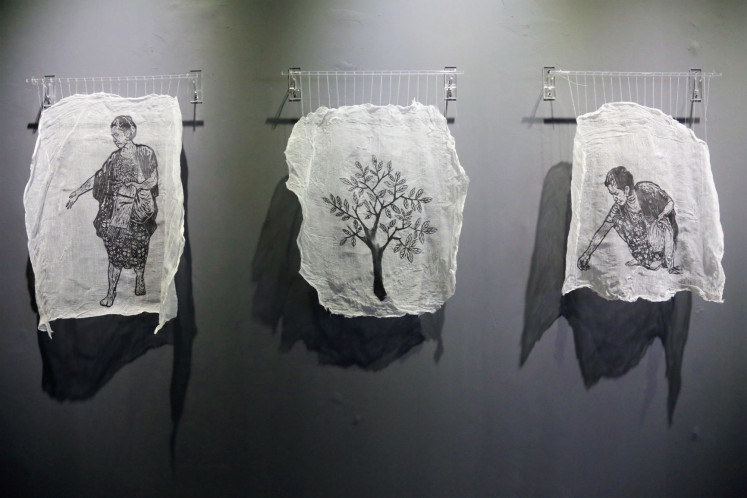Popular Reads
Top Results
Can't find what you're looking for?
View all search resultsPopular Reads
Top Results
Can't find what you're looking for?
View all search results‘Into the Future’ celebrates female Indonesian artists
An ongoing exhibition and a newly launched book celebrate the progress and the diverse talents of female Indonesian artists.
Change text size
Gift Premium Articles
to Anyone
T
wenty-one female Indonesian artists are featured in both an exhibition and its corresponding book, one written and compiled by writer and art curator Carla Bianpoen.
The exhibition, held at the National Gallery of Indonesia until March 16, aims to draw focus to the strengths of female perceptions while the book, entitled Into the Future just like the exhibition, details the works of the featured female artists.
Coming from cities like Jakarta, Bandung and Yogyakarta, the artists include Natasha Gabriella Tontey, Ayu Arista Murti, Dita Gambiro, Fika Ria Santika, Andrita Yuniza Orbandy, Cecilia Patricia Untario, Kinez Riza, Etza Meisyara, Restu Ratnaningtyas, Sanchia Hamidjadja and Syagini Ratna Wulan, to name a few.
In the name of women: Through the book, author and art curator Carla Bianpoen aims to document the wide range of female Indonesian artists who have made groundbreaking art. (The Jakarta Post/Iqbal Yuwansyah)
Through the book, Carla said she aims to document the art of women, in the name of women, celebrating the wide range of female Indonesian artists who have made groundbreaking art and achievements.
Thus, it wasn’t hard for her to seek out the 21 names, coupled with her deep two-decade-long research into the Indonesian art world.
“[The book] serves as an objective visual analysis that is not weighed down by personal tastes,” she explained during a discussion at the gallery.
Carla is renowned as an art writer in many media, both local and international and as a curator for Indonesia’s entries into the prestigious Venice Biennale events of 2013 and 2015. She also received an Adhikarya Rupa visual arts award from the Tourism and Creative Industry Ministry in 2014.
“Up until now there hasn’t been any specific literature that documents the art of female Indonesian artists," said the 83-year-old, who also co-authored Indonesia Women Artists: The Curtain Opens in 2007, considered as the first and only book on Indonesian women artists.
‘Menabur Benih’ (Spreading the seed) by Theresia Agustina Sitompul. (The Jakarta Post/Wendra Ajistyatama)
She documents the subject through the context of outlining the biographies of the 21 featured artists so that they can serve as better thresholds to understanding the women’s art.
A distinct characteristic of female artists, she added, was that women tend to create art outside of the market taste and demand.
An example of this is Carla’s observation that most of the women’s art tends to depict and describe ideas that are rooted in daily life.
A work by Ayu Aristra Murti entitled Embryo Harapan, she said, focuses the lens on natural disasters, but with an optimism delivered through the artist’s choice of bright colors, conveyed through the idea of nature as well.
“Therefore their creations exhibit a more visible depiction of art that comes straight from the heart – something genuine, something true,” Carla says.
“Many of them are telling tales of how they survive the world and any adversity they might feel.”
‘Ode to My Homeland’ by Etza Meisyara (The Jakarta Post/Wendra Ajistyatama)
The exhibition itself showcases a wide range of mediums and artistry among the 21 artists, who are all aged between 21 and 48.
With the Cemara 6 Galeri & Museum being the co-organizer and Carla the co-curator with Citra Smara Dewi, the works displayed convey a feminine viewpoint of the world around them, including the mundane aspects and struggles of domestic life, their reactions towards national disaster and how they get by in a patriarchal society.
One intriguing display comes from Dita Gambiro and her Distorted Reality installation, which featured layers of clothing and aimed to explain the meaning behind self-perception, immaculate presentation and the pressures that women tend to follow when presenting themselves in front of others.
Another metaphoric installation came from the mind of Mardita Sutantio, entitled Speculative Present. Several pendulums swing from her wall-mounted display, which suggests that time is a construct that simplifies the similarity between yesterday and today. The present symbolized here evokes fresh new worries every time a new day starts while also filling us with new opportunities and new ways to develop ourselves.
The diverse range of themes from the diverse pool of women in this exhibition, according to Carla, shows that the proven depths of female perception and thought cannot be ignored any more, especially in a rapidly evolving world.
“The essence of this exhibition is the fact that as technology progresses further and further and new forms of knowledge are found every day, it is now impossible to ignore female progress,” she says.
“New challenges are therefore always there for those in the contemporary art world, thereby creating art of another kind. Therefore, the future.” (ste)
-- Curatorial tour is to be held on March 9 at 10:30 a.m. at the National Gallery of Indonesia and followed by Art Talk at 2 p.m. On March 14, a discussion on visual art, intellectual property and creative economy is to be held at 2 p.m.













